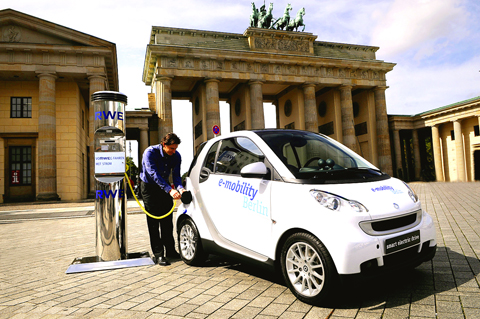What shape will the plug for recharging your future electric vehicle take?
That question is becoming a pressing matter for automakers. The global auto industry has yet to agree on a standardized shape for the connectors that will replenish the batteries of electric cars, though the Society of Automotive Engineers has been working on standards for such a plug for more than two years.
Issues of this sort must be resolved before many of the electric powertrains displayed at the Detroit auto show this month will be able to take to the road in large numbers. While the breadth and diversity of electric car proposals seen in Detroit seemed to affirm their inevitability — despite obstacles like US$0.52 per liter gas at nearby pumps and a grim car market overall — the efforts at electrification of the vehicle fleet, to use the buzz phrase of the moment, also raised awareness of the challenges that automakers will face.

PHOTO: NY TIMES NEWS SERVICE
Making the electricity available to recharge batteries is just one of the hurdles carmakers must address. How far the cars will go on a charge, how long the recharging process will take, and even how drivers will be billed for electricity when they recharge away from home, are also matters that engineers are scrambling to sort out.
David Champion, director of auto testing at Consumer Reports, said that the promises being made for electric cars are sure to lead to some buyer disappointments. Commenting on vehicles he saw at the Detroit show like the Chevrolet Volt — a plug-in hybrid with a 64km all-electric range, which General Motors says will go on sale late next year — he noted that the ranges are mostly predicated on low speed and intermittent city driving, where an electric powertrain shines.
“You get that vehicle out on the highway and cruise along at 70 miles per hour [112kph], that range is going to plummet,” Champion said.
The Volt’s powertrain design, generally referred to as a series hybrid, incorporates a gasoline-driven generator that can keep the car going until it can plug in for a recharge.
Add the amenities that Americans expect in their cars — air-conditioning turned up high, audio systems set to deafening levels — and battery-powered vehicles may be spending as many of their kilowatt hours on comfort as they do on cruising.
The issue puts pressure on engineers to reduce charging time. In news conferences during the show’s press preview days, the hours-to-recharge figure seemed to be the newest bragging point for some automakers, replacing zero-to-60 times and fuel-efficiency ratings as the numbers that mattered.
The Mini E, for instance, can be recharged in just 2.5 hours using a special home charging station. The battery-powered Minis — 500 are being leased to individuals in the Los Angeles and New York metro areas for one-year terms — can also be recharged on household current. But if the current comes from a standard 110-volt wall socket, it will take 23 hours to restore the car’s 240km maximum range.
Public charging stations were announced for the Smart Electric Drive cars that are part of a 100-vehicle Berlin test fleet to be put on the road this year. The stations include a link to a computer chip in the car that allows charging with the lowest-cost electricity, choosing off-peak times, and possibly even selecting green energy sources by detecting when wind farms or solar panels are feeding to the energy grid.
BYD, a Chinese carmaker, may have trumped them all. It showed the F3DM plug-in hybrid, already on sale in China, and said that although normal battery-pack charging using home current would take nine hours, special “industrial” charging could snap the battery back to 80 percent of capacity in 15 minutes. BYD did not describe the industrial charging system.
Hybrids like the Toyota Prius are not limited by battery capacity, since they run on their gasoline engines for most driving. Toyota announced in Detroit that it would lease a plug-in version of the Prius to commercial customers later this year. The car will be equipped with lithium-ion batteries, which can provide a longer range than the nickel-metal hydride batteries in the regular Prius.
But at the Detroit show this year the momentum in plug-in hybrids seemed to be swinging toward series hybrids, in which the piston engine drives only a generator to charge the battery, with no mechanical connection to the wheels. General Motors calls this solution, used for the Volt and seen also in the Cadillac Converj design study, an extended-range electric vehicle, and the terminology seemed to be catching on with other automakers.

The Central Weather Administration (CWA) yesterday said it expected to issue a sea warning for Typhoon Fung-Wong tomorrow, which it said would possibly make landfall near central Taiwan. As of 2am yesterday, Fung-Wong was about 1,760km southeast of Oluanpi (鵝鑾鼻), Taiwan’s southernmost point, moving west-northwest at 26kph. It is forecast to reach Luzon in the northern Philippines by tomorrow, the CWA said. After entering the South China Sea, Typhoon Fung-Wong is likely to turn northward toward Taiwan, CWA forecaster Chang Chun-yao (張峻堯) said, adding that it would likely make landfall near central Taiwan. The CWA expects to issue a land

Taiwan’s exports soared to an all-time high of US$61.8 billion last month, surging 49.7 percent from a year earlier, as the global frenzy for artificial intelligence (AI) applications and new consumer electronics powered shipments of high-tech goods, the Ministry of Finance said yesterday. It was the first time exports had exceeded the US$60 billion mark, fueled by the global boom in AI development that has significantly boosted Taiwanese companies across the international supply chain, Department of Statistics Director-General Beatrice Tsai (蔡美娜) told a media briefing. “There is a consensus among major AI players that the upcycle is still in its early stage,”

The Central Weather Administration (CWA) yesterday said it is expected to issue a sea warning for Typhoon Fung-wong this afternoon and a land warning tomorrow. As of 1pm, the storm was about 1,070km southeast of Oluanpi (鵝鑾鼻), Taiwan’s southernmost point, and was moving west-northwest at 28 to 32kph, according to CWA data. The storm had a radius of 250km, with maximum sustained winds of 173kph and gusts reaching 209kph, the CWA added. The storm is forecast to pass near Luzon in the Philippines before entering the South China Sea and potentially turning northward toward Taiwan, the CWA said. CWA forecaster Chang Chun-yao (張峻堯) said

Japanese Prime Minister Sanae Takaichi yesterday said that China using armed force against Taiwan could constitute a "survival-threatening situation" for Japan, allowing the country to mobilize the Japanese armed forces under its security laws. Takaichi made the remarks during a parliamentary session while responding to a question about whether a "Taiwan contingency" involving a Chinese naval blockade would qualify as a "survival-threatening situation" for Japan, according to a report by Japan’s Asahi Shimbun. "If warships are used and other armed actions are involved, I believe this could constitute a survival-threatening situation," Takaichi was quoted as saying in the report. Under Japan’s security legislation,